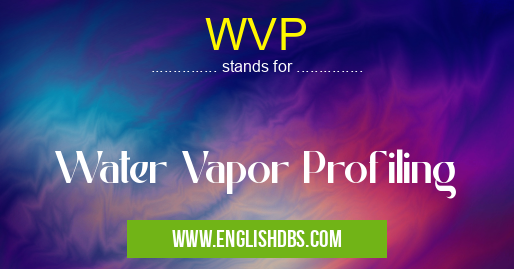What does WVP mean in CHEMISTRY
Water vapor plays an important role in the water cycle and therefore has a major effect on weather patterns and climate. Water Vapor Profiling (WVP) is a technique used to measure changes in atmospheric water vapor concentration over time by obtaining vertical profiles of the atmosphere. WVP is necessary for meteorological forecasting, providing data for numerical models to use when predicting weather events.

WVP meaning in Chemistry in Academic & Science
WVP mostly used in an acronym Chemistry in Category Academic & Science that means Water Vapor Profiling
Shorthand: WVP,
Full Form: Water Vapor Profiling
For more information of "Water Vapor Profiling", see the section below.
What is WVP?
Water Vapor Profiling (WVP) utilizes vertical and horizontal measurements to obtain atmospheric profiles of atmospheric water vapor concentrations. By measuring water vapor content up to several kilometers above ground level, meteorologists can better predict weather events and other environmental phenomena that depend on the exact levels of water vapor present in the atmosphere. Different instruments, such as radiosondes, lasers or Global Positioning System satellites are employed during WVP measurements depending on the desired resolution and accuracy of measurements. A radiosonde attached to a balloon is often preferred since it allows for long range profiling up to a few kilometers above ground level with high accuracy.
Advantages of WVP
Due to its accuracy and ability to provide detailed information about various atmosphere layers, Water Vapor Profiling has many advantages over other techniques used for atmospheric observation. Measurements from different sensors can be fused together into one profile, allowing for greater insight into different conditions such as humidity and turbulence conditions throughout the atmosphere at any given moment. This in turn allows meteorologists to make more accurate short-term forecasts regardless of where they are performed since the same information can be obtained at multiple locations around the world almost simultaneously!
Essential Questions and Answers on Water Vapor Profiling in "SCIENCE»CHEMISTRY"
What is Water Vapor Profiling?
Water Vapor Profiling (WVP) is the process of measuring water vapor in the atmosphere using various instruments and techniques. WVP measurements provide data about how atmospheric water vapor affects climate, weather, and air quality.
How does Water Vapor Profiling work?
Water vapor profiling uses instrumentation such as radar and lidar to measure the amount of water vapor present in the atmosphere. The instrument measures the signal strength of microwaves or lasers from a particle backscattered from an airborne platform. This signal is then used to calculate the concentration of water vapor molecules in different parts of the atmosphere.
What kind of data can be obtained by Water Vapor Profiling?
Water Vapor Profiling produces data that can be used to analyze many aspects of Earth's atmospheric environment such as air temperature, moisture content, and wind speed. Additionally, WVP measurements can help assess drought risk, monitor climate change, and detect pollutants in the atmosphere.
Who uses Water Vapor Profiling information?
Water Vapor Profiling information is used by meteorologists, climate scientists, atmospheric researchers, and other professionals who need to analyze atmospheric conditions for various purposes including forecasting weather patterns and studying climate change.
What are some advantages of using Water Vapor Profiling?
Some advantages of using WVP include being able to assess drought risks more accurately, providing more detailed information about local weather conditions than traditional methods such as satellite imagery alone, monitoring changes in humidity levels over time which helps detect pollution sources and understanding atmospheric dynamics such as cloud formation better.
Are there limitations to usingWater Vapor Profiling?
Yes, there are some technical and environmental limitations when it comes to using WVP such as certain environmental conditions making it difficult for instruments to measure accurately due to interference from clouds or aerosols in the atmosphere and constraints on deploying instruments at certain altitudes due to safety concerns. Additionally, because WVP requires an airborne platform for measurements this limits its usage in certain regions where airspace is restricted.
Final Words:
In conclusion, Water Vapor Profiling provides a wealth of information which is crucial for understanding our changing environment not only on a local scale but also globally across all regions with differing climates, enabling us to better forecast weather patterns while monitoring potential changes in our atmosphere due to global warming or any other form of pollution. In addition, WVP is respected as an invaluable tool by professionals within meteorology, environmental science, climatology and all related fields alike due to its accuracy and ability to provide detailed data about various parts of our atmosphere with varying conditions with ease!
